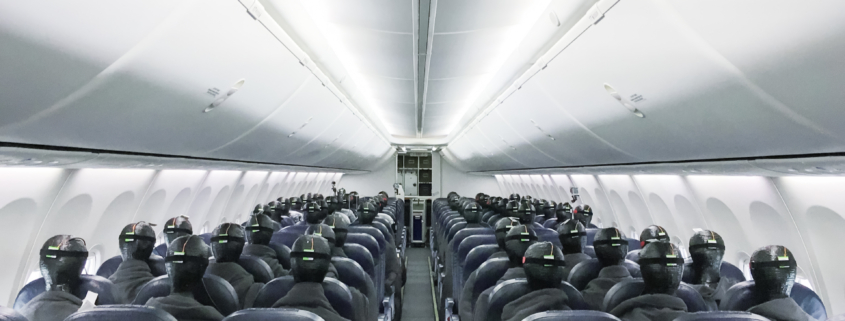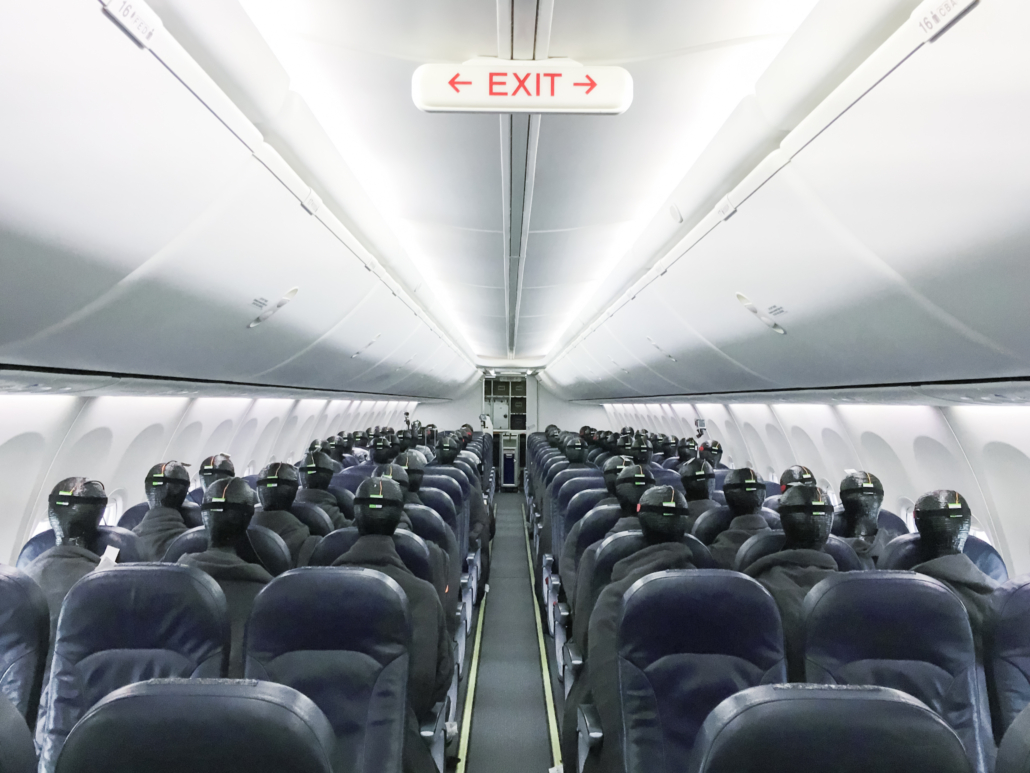Royal NLR has carried out a joint study with RIVM into the risk of a passenger falling ill by breathing in the coronavirus SARS-CoV-2 while on board an aircraft. Measures have been implemented to reduce the risk of an infectious passenger boarding an aircraft. If despite measures an infectious passenger is on board the cabin, then on average fellow passengers – within a section of seven rows around the infectious passenger – run a relatively low risk of falling ill from COVID-19. For example, a lower than in unventilated rooms of the same dimensions.
In the Dutch aviation sector, there are various measures in place to prevent a passenger who is infected with COVID-19 (coronavirus disease 2019) from boarding a plane. For instance, all air passengers have to provide a health certificate, with an additional obligation for travellers from very high risk areas being to have had a rapid test for antigens no more than 24 hours before boarding. Unless he or she can show a negative test result, the passenger will not be allowed to board the aircraft.
In the case of a low incidence of the virus at the departure location and a negative test result for the boarding, it is unlikely that an infectious passenger will get on board. In the unlikely event that an infectious person is on board after all, there are various factors that affect the possible transmission of the virus on aircraft. In order to evaluate the risks of COVID-19 on board aircraft, the Dutch Ministry of the Infrastructure and Water Management tasked Royal NLR – Netherlands Aerospace Centre and RIVM (the Dutch National Institute for Public Health and the Environment) with carrying out a scientific study on this issue. The starting point here was that the coronavirus measures for the aviation sector – such as the wearing of face masks – are being complied with. Research was carried out into the risk of illness as the result of aerosolised SARS-CoV-2 virus particles (severe acute respiratory syndrome coronavirus 2) being shed by an infectious passenger in an aircraft cabin. This study did not look into the transmission of the virus via direct contact and/or surfaces.
Conclusions
Measurements and simulations were used to assess a range of situations. For a typical cruise flight duration for each of the aircraft studied, the risk of COVID-19 from breathing in virus particles by passengers in the seven rows around the infectious passenger was calculated to be between 1:1800 and 1:120. In the case of a so-called ‘super shedder’ – a person who sheds an average of 300 times as many virus particles – the average risk increased to between 1:370 and 1:16. According to the report, it is these types of biomedical factors that have the greatest effect on the risk. Risks also increase for a longer flight duration. The wearing of face masks on board reduces the risk.
The study results show that the level of risk declines as the distance from the infectious passenger increases. This is why the report proceeds on the basis that passengers who are more than 3 rows from the infectious passenger are not running any risk. The researchers estimate that for between 2 and 44 cruise flights, the presence of a ‘regular’ infectious passenger may result in at least 1 case of COVID-19. For a ‘super shedder’, this risk is estimated to be between 1 and 9 flights. These figures apply for situations where an infectious passenger is present in the aircraft cabin. The likelihood of this occurring depends on such factors as the number of persons infected with SARS-CoV-2 in the population and whether a negative test result is needed to board the aircraft. Based on data from 7 June and a mandatory test, the researchers estimate that every 11 to 33 flights an infectious passenger could be on board. For those passengers on board, it is estimated that fewer than 3% are super shedders.
Approach taken
In addition to an extensive literature study that was published in October 2020, measurements were carried out on board three types of aircraft that often fly from Schiphol Airport (Amsterdam/Netherlands) provided by three airline companies. The results of the literature study demonstrated the relevance of both the cruise flight phase (the most common situation during a flight) and the taxi phase. As a result, both were studied. The measurements were carried out for a cabin section of seven rows in the economy class, with dummies in the seats to imitate passengers. During some measurements, the dummies were warmed in order to imitate the heat emission from normal passengers. An ‘infectious passenger’ was seated in the middle row, who artificially emitted saliva that contained no actual virus. The numbers and volumes of particles in the cabin section were then determined, by means of sensors placed in the cabin and on the dummies.
As well as measurements, simulations were carried out to analyse the dispersion of aerosol particles under different conditions during the cruise flight situation, such as the effect that the seating position of the ‘infectious passenger’ has on the various seats in a row.
- You can download the final report (published at June 21) from the NLR website. See: https://reports.nlr.nl/xmlui/handle/10921/1568. Correction: a previous version of the report incorrectly stated EASA and ICAO explicitly recommend using non-medical facemasks in the aircraft cabin, whereas medical masks are advised. The text has been adjusted in this version. NOTE: the risk assessment in CORSICA assumes disposable so-called ‘surgical’ masks are worn. This type is a commonly used mask in the Netherlands.
- This study did not look into transmission routes other than that of carrier (i.e. virus-bearing) aerosol particles.
In anticipation of this study, in July 2020 NLR published an analysis of HEPA filters that concluded that 99.1% of flight movements made to and from Dutch airports in 2019 were very probably made by aircraft that were equipped with HEPA filters. - According to the study, the recirculation of aerosol particles via a cabin ventilation system that has been fitted with HEPA filters occurs not at all (or only to a very limited extent) within the aircraft section studied.
 Royal NLR
Royal NLR
 LIG Nex1
LIG Nex1